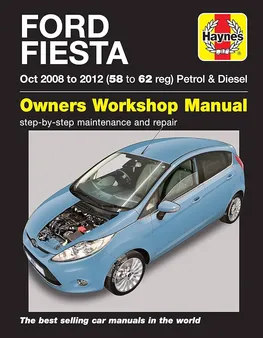Table of Contents
Welcome to Westernfordhcm, your trusted source for Maintenance Tips for Ford Fiesta Owners. Maintaining your Ford Fiesta is essential for ensuring its optimal performance, reliability, and longevity. By following a regular maintenance schedule and addressing potential issues promptly, you can extend the lifespan of your vehicle and avoid costly repairs. This comprehensive guide provides essential Maintenance Tips for Ford Fiesta Owners, covering everything from routine maintenance to troubleshooting common problems. Whether you're a seasoned car owner or a new Fiesta enthusiast, this guide will empower you with the knowledge and confidence to keep your vehicle running smoothly for years to come.

The Ultimate Maintenance Tips for Ford Fiesta Owners: A Comprehensive Guide
Maintenance Task | Frequency | Importance |
|---|---|---|
Oil Change | Every 5,000-7,500 miles | Crucial for engine lubrication and protection |
Tire Rotation | Every 5,000-7,500 miles | Ensures even tire wear and extends lifespan |
Battery Inspection | Every 12 months | Prevents unexpected breakdowns and ensures reliable starting |
Brake Pad Replacement | As needed (typically every 30,000-50,000 miles) | Essential for safe and effective braking |
Spark Plug Replacement | Every 30,000-60,000 miles | Improves engine performance and fuel efficiency |
Coolant Flush | Every 30,000-50,000 miles | Prevents overheating and protects the cooling system |
Transmission Fluid Change | Every 30,000-60,000 miles | Ensures smooth and efficient transmission operation |
I. Regular Maintenance Schedule
Frequent Inspections
- Check oil level and top off as needed
- Inspect tire pressure and tread depth
- Check fluid levels (coolant, brake fluid, power steering fluid)
- Inspect battery terminals for corrosion
- Check air filter for cleanliness and replace if necessary
These regular inspections can help you identify potential issues early on, preventing them from becoming more serious and costly repairs. By following a regular maintenance schedule and addressing potential issues promptly, you can extend the lifespan of your Ford Fiesta and ensure it runs smoothly for years to come.
Scheduled Maintenance
In addition to frequent inspections, it's important to follow the recommended maintenance schedule outlined in your Fiesta's owner's manual. This schedule will vary depending on the age and mileage of your vehicle, but some common services include:
- Regular oil changes (typically every 5,000-7,500 miles)
- Tire rotations (every 5,000-7,500 miles)
- Spark plug replacements (every 30,000-60,000 miles)
- Fuel filter replacements (every 30,000-60,000 miles)
- Brake pad replacements (when needed, typically every 30,000-50,000 miles)
By following the recommended maintenance schedule, you can help keep your Fiesta running at its best. You'll also extend its lifespan and avoid costly repairs down the road.
[Related post: Ford Fiesta Maintenance Checklist]

Regular Maintenance Schedule
II. Common Problems and Solutions
Battery Issues
A common problem with Ford Fiestas is a dead or weak battery. This can be caused by a number of factors, including leaving the lights on, running the engine for short periods of time, or having a faulty alternator. If your Fiesta's battery is dead, you can try jump-starting it or replacing the battery. If the problem persists, you should have your alternator checked.
Here are some tips for preventing battery problems in your Ford Fiesta:
- Turn off the lights when you leave the car.
- Run the engine for at least 30 minutes each time you drive it.
- Have your alternator checked regularly.
Electrical Problems
Another common problem with Ford Fiestas is electrical problems. These can range from minor issues, such as flickering lights, to more serious problems, such as a faulty wiring harness. If you are experiencing any electrical problems with your Fiesta, you should have it checked out by a qualified mechanic.
Here are some tips for preventing electrical problems in your Ford Fiesta:
- Keep your car clean, both inside and out.
- Avoid driving through deep water or mud.
- Have your electrical system checked regularly.
Engine Problems
Engine problems are less common in Ford Fiestas than battery or electrical problems, but they can still occur. Some of the most common engine problems include:
- Oil leaks
- Coolant leaks
- Spark plug problems
- Timing belt problems
If you are experiencing any engine problems with your Fiesta, you should have it checked out by a qualified mechanic.
Here are some tips for preventing engine problems in your Ford Fiesta:
- Change your oil and filter regularly.
- Check your coolant levels regularly.
- Replace your spark plugs according to the manufacturer's recommendations.
- Have your timing belt replaced according to the manufacturer's recommendations.
III. DIY Maintenance Tips
Quick Fixes
- Fluids check: Regularly check fluids, including engine oil, coolant, brake fluid, and transmission fluid, and top off as needed.
- Tire inspection: Regularly inspect tires for wear, cracks, or punctures, and inflate to the recommended tire pressure.
- Battery terminals cleaning: Clean battery terminals to prevent corrosion and ensure optimal electrical flow.
DIY Maintenance Tips for Ford Everest Owners
More Involved Tasks
- Spark plug replacement: Replace spark plugs as recommended in your owner's manual to ensure optimal engine performance and fuel efficiency.
- Air filter replacement: Replace the air filter as recommended in your owner's manual to improve airflow and engine efficiency.
- Brake pad replacement: Inspect brake pads and replace as needed to maintain safe and effective braking.
Maintenance Schedule for Ford Maverick Owners

DIY Maintenance Tips
IV. Professional Maintenance Tips
Regular maintenance is crucial for the longevity and performance of your Ford Fiesta. By following a comprehensive maintenance schedule and addressing potential issues promptly, you can extend the lifespan of your vehicle and avoid costly repairs. Here are some professional maintenance tips to keep your Fiesta running smoothly:
- Regular Oil Changes: Oil changes are essential for engine lubrication and protection. Follow the manufacturer's recommended intervals for oil changes, typically every 5,000-7,500 miles.
- Tire Rotation: Tire rotation ensures even tire wear and extends their lifespan. Rotate your tires every 5,000-7,500 miles or as recommended by your mechanic.
- Battery Inspection: Batteries can fail without warning, leading to unexpected breakdowns. Have your battery inspected every 12 months to prevent such issues.
- Brake Pad Replacement: Brake pads wear down over time, affecting braking performance. Replace brake pads as needed, typically every 30,000-50,000 miles.
- Spark Plug Replacement: Spark plugs ignite the air-fuel mixture in the engine. Replace spark plugs every 30,000-60,000 miles to improve engine performance and fuel efficiency.
In addition to these routine maintenance tasks, there are other important aspects to consider:
- Coolant Flush: Coolant prevents overheating and protects the cooling system. Flush the coolant every 30,000-50,000 miles to maintain its effectiveness.
- Transmission Fluid Change: Transmission fluid ensures smooth and efficient transmission operation. Change the transmission fluid every 30,000-60,000 miles.
- Fuel Filter Replacement: Fuel filters prevent impurities from entering the fuel system. Replace the fuel filter as recommended by your mechanic, typically every 20,000-30,000 miles.
- Air Filter Replacement: Air filters ensure clean air enters the engine. Replace the air filter every 12,000-15,000 miles or as recommended by your mechanic.
- Cabin Air Filter Replacement: Cabin air filters improve air quality inside the vehicle. Replace the cabin air filter every 12,000-15,000 miles or as recommended by your mechanic.
By following these professional maintenance tips, you can keep your Ford Fiesta in optimal condition, ensuring its reliability, performance, and longevity.

Professional Maintenance Tips
V. Conclusion
By following the Maintenance Tips for Ford Fiesta Owners outlined in this guide, you can ensure that your vehicle remains in optimal condition for years to come. Regular maintenance, timely repairs, and addressing potential issues promptly will not only extend the lifespan of your Fiesta but also enhance its performance, safety, and reliability. Remember, a well-maintained car is a happy car, and a happy car will provide you with years of trouble-free driving pleasure. If you have any further questions or concerns about your Ford Fiesta's maintenance, don't hesitate to consult your trusted mechanic or refer to the owner's manual for specific recommendations.